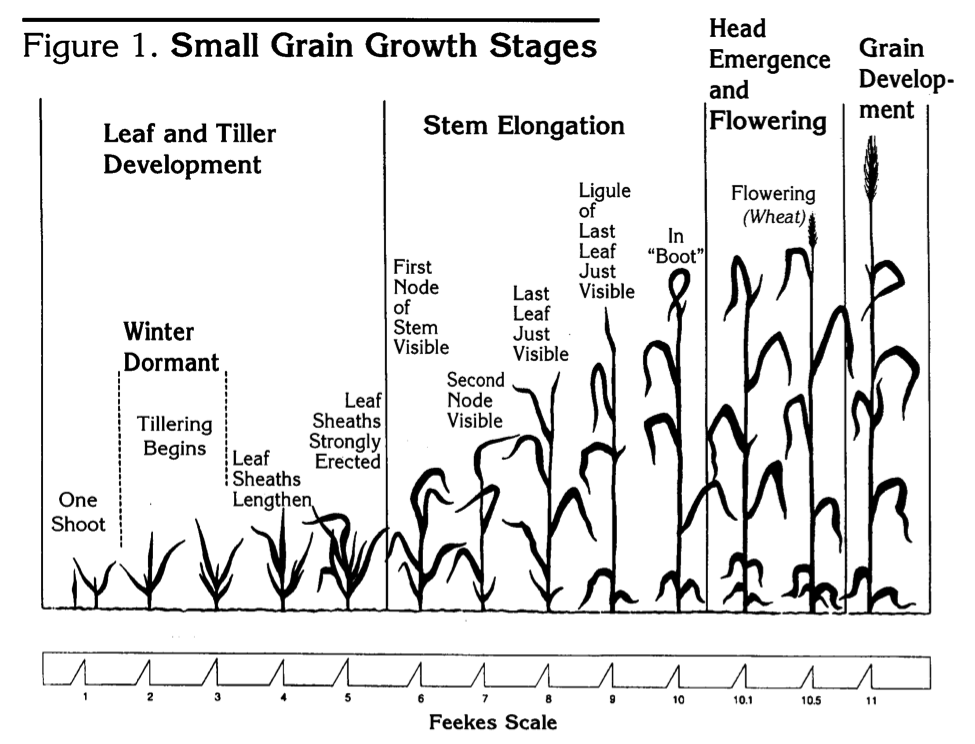Grazing Small Grains

Small cereal grains, such as wheat, rye, oats, and barley, are multipurpose crops that can be used for grazing, silage, or hay production. Grazing pure stands of small grains is an effective way to extend the grazing season into the late fall and early winter, and then again in February/March for early spring grazing. Small grains are commonly planted in Kentucky as part of the crop rotation with corn and soybeans. They also serve as a cover crop to reduce soil erosion and utilize previous nitrogen applications.
For grazing, small grains are typically planted in the early fall. They should be seeded at a depth of one to two inches. Refer to the table for specific seeding rates. Small grains are typically higher in digestible energy and protein than other forages, specifically tall fescue. Forage quality in small grains drops markedly with maturity, so it’s important to graze while in the vegetative stage of maturity.
Rotational grazing is recommended to keep small grains in a vegetative state and allow a rest period for regrowth. Grazing can begin when forage is well established at a forage height of six to eight inches. Animals should be removed when forage height reaches three to four inches. Once regrowth reaches six to eight inches, the forage can be grazed again.
Wheat
Wheat is one of the most versatile small grains. It is well adapted to most soils in Kentucky and is commonly used in rotation with corn or soybeans. Wheat can be sown later in the fall (early to mid-October) as it is more winter hardy than barley. It is advised not to plant too early in the fall due to susceptibility of the Hessian fly if a subsequent grain crop is desired. The Hessian fly emerges in the early fall and lays their eggs on wheat, causing damage to the stand and affecting yield and quality. Seeding later in the season after the Hessian fly has laid their eggs can help to avoid this and prevent damage to the stand. It is recommended to seed between October 6 and 15 to avoid the Hessian fly. There are some new winter wheat varieties with Hessian fly resistance that can be sown as early as late August; however, Hessian fly resistance is dependent on the type of Hessian fly present, so there still may be some risk when planting early in the season.
Management practices for planting differ depending on intended use. For example, you can graze small grains and then harvest for grain, or you can simply graze with no harvest. If a grain crop is desired, typically 30 lbs of nitrogen per acre is recommended for proper establishment. When the forage is to be grazed, an additional 30 lbs of nitrogen should be applied at seeding. Also, if planning on harvesting wheat after grazing, animals need to be removed before the jointing stage, or stem elongation. This stage usually occurs in late February when the head of the plant moves up from below the ground and into the plant. If the head is bitten off, there will be no seed head to emerge and the main stem will die. As a result, new tillers will emerge at the base of the plant to compensate for the loss.
Barley, Rye, and Oats
Barley should be seeded in the early fall (mid-September to early October). Barley must be well established before winter as it is not as winter hardy as the other small grains. From a forage perspective, it produces lower yields, but is higher in quality with greater digestibility than the other species. Rye is the most winter hardy of all the small grains. Its rapid growth makes it one of the most productive small grains. However, due to its early maturing nature, it must be closely monitored to ensure it is in the vegetative stage or the boot stage for grazing or harvesting as stored forage, respectively. Winter oats is similar to barley in that it should be seeded in the early fall to allow time for establishment before winter. Oats generally produce more tonnage in the fall compared to wheat, making them a good option for fall and early winter grazing. Oats are less winter hardy than the other small grains. Oats are at a higher risk for being killed off during the winter and less likely to be available for early spring grazing, especially with Kentucky’s freeze and thaw patterns. Keep in mind that each species and variety is adapted to different soil types and should be considered when choosing a species and variety.
For more information on grazing small grains, refer to AGR-160: Managing Small Grains for Livestock Forage.
| Small Grain | Seeding Rate (For Forage) |
|---|---|
| Wheat | 2-2.5 bu/acre |
| Barley | 2-3 bu/acre |
| Rye | 1.5-2.5 bu/acre |
| Winter Oats | 2.5-3 bu/acre |
Categories:
Winter
Extending the Grazing Season


